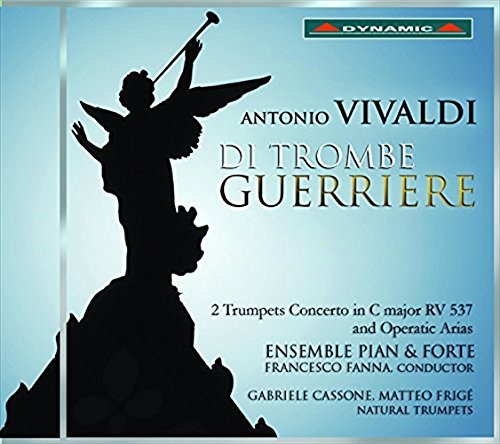
Ensemble Pian & Forte, Di Trombe Guerriere (Dynamic CDS 7710) 2015.
Gabriele Cassone and Matteo Frigé, trumpet
Francesca Cassinari, Marta Fumagalli, Roberto Balconi, and Mauro Borgioni, voice
The author of the liner notes for this CD, Alessandro Borin, seems to be under the impression that trumpeters think Vivaldi somehow neglected the instrument. We all know about the famous Concerto for Two Trumpets and the ever-popular Gloria, but if there were still any doubters out there as to Vivaldi’s interest in the trumpet this recording will hopefully lay such mistaken views to rest. Of course, Gabriele Cassone and Matteo Frigé play a fine (apparently obligatory) rendition of the Concerto (I think I’ve got about a dozen of them now) as well as the popular “Combatta un Gentil Cor” from the opera Tito Manlio; they also play a bunch of other far more obscure selections for trumpet gleaned from Vivaldi’s operas.
The really interesting part of the recording for the brass enthusiast, historically speaking at least, are the seven trumpet and voice duets taken from six of Vivaldi’s many operas. Selected from Montezuma, Il Teuzone, Tito Manlio, Catone in Utica, Scanderbeg, and La Fida Ninfa, they provide a much more complete picture of Vivaldi’s trumpet writing than one might have expected. My impression based on this recording was that the composer had a handful of tricks up his sleeve for the trumpet and that he rotated these in and out from opera to opera. That is, there is just enough variety in his melodies to differentiate one from another, though there are enough similarities to the point that you may get the musical version of déjà vu if listening in one sitting. There are also two concertos on this CD that are not for trumpet at all (RV 554a for Organ, Violin, and Cello and RV 779 for Oboe, Violin, Organ and Chalumeau); certain sections in both reminded me of Vivaldi’s trumpet writing: perhaps this is why these particular works were included, though the liner notes are silent as to the underlying reasoning.
The playing (and singing) on this recording are very good indeed, but with a caveat. I am under the distinct impression that Cassone and Frigé play without modern vent holes, but the CD does not provide specific information. So either they play on true natural trumpets very well (I presume this to be the case) or they have vented instruments with occasional minor tuning lapses (which seems unlikely given Cassone’s towering reputation). Somewhat confusing the issue is that the photos of Cassone and Frigé in the booklet are at odds with one another: Cassone poses with an unvented trumpet while Frigé clearly holds a vented instrument. I must confess to not being too interested in debating the merits or reopening old debates, but there is still something impressive about a well-done recording on natural trumpets such as I presume this one is.
Cassone here provides us with food for thought by revealing a larger and more representative cross-section of Vivaldi’s works for trumpet than is usual. The playing is idiomatic in every way, ranging from the delicate obbligato lines typical of a trumpet accompanying an operatic voice to the obnoxious noise expected from a wartime trumpet in a battle scene. Those who want to play (or hear) the famous Concerto for Two Trumpets from a broader and more considered musical perspective will need to buy this CD right away. Those who just like Vivaldi and/or the natural trumpet simply on their own merits should probably do the same!
Bryan Proksch, Lamar University



